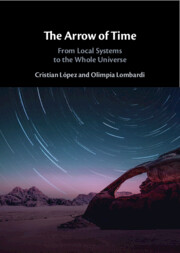Book contents
- The Arrow of Time
- The Arrow of Time
- Copyright page
- Contents
- Contributors
- Preface
- Acknowledgments
- Part I Local Systems
- Part II The Arrow of Time and Philosophical Issues
- Part III The Arrow of Time and Time-Reversal Invariance
- 8 Time for Pancakes: Time Reversal and Ontology
- 9 Insights into Quantum Time Reversal from the Classical Schrödinger Equation
- 10 Saving the Appearances: The Direction of Time and Time-Reversal Invariance
- Part IV The Whole Universe
- Index
- References
9 - Insights into Quantum Time Reversal from the Classical Schrödinger Equation
from Part III - The Arrow of Time and Time-Reversal Invariance
Published online by Cambridge University Press: 28 October 2025
- The Arrow of Time
- The Arrow of Time
- Copyright page
- Contents
- Contributors
- Preface
- Acknowledgments
- Part I Local Systems
- Part II The Arrow of Time and Philosophical Issues
- Part III The Arrow of Time and Time-Reversal Invariance
- 8 Time for Pancakes: Time Reversal and Ontology
- 9 Insights into Quantum Time Reversal from the Classical Schrödinger Equation
- 10 Saving the Appearances: The Direction of Time and Time-Reversal Invariance
- Part IV The Whole Universe
- Index
- References
Summary
The need to implement time reversal via complex conjugation in quantum theory has always been a bit of a puzzle. Why should i go to –i under temporal reflection when it has no spatiotemporal dimensions? I’ll provide a new insight into this question by showing how the little-appreciated “quantum-looking” classical Schrödinger equation of Schiller and Rosen faces the exact same problem. Since we know how to escape this problem classically, this observation teaches us one way to solve the problem quantum mechanically too. Big picture: if I’m right, the puzzle over quantum time reversal is connected to the interpretation of quantum theory.
Information
- Type
- Chapter
- Information
- The Arrow of TimeFrom Local Systems to the Whole Universe, pp. 184 - 197Publisher: Cambridge University PressPrint publication year: 2025
References
Accessibility standard: WCAG 2.1 AA
Why this information is here
This section outlines the accessibility features of this content - including support for screen readers, full keyboard navigation and high-contrast display options. This may not be relevant for you.Accessibility Information
Content Navigation
Allows you to navigate directly to chapters, sections, or non‐text items through a linked table of contents, reducing the need for extensive scrolling.
Provides an interactive index, letting you go straight to where a term or subject appears in the text without manual searching.
Reading Order & Textual Equivalents
You will encounter all content (including footnotes, captions, etc.) in a clear, sequential flow, making it easier to follow with assistive tools like screen readers.
You get concise descriptions (for images, charts, or media clips), ensuring you do not miss crucial information when visual or audio elements are not accessible.
Visual Accessibility
You will still understand key ideas or prompts without relying solely on colour, which is especially helpful if you have colour vision deficiencies.
Structural and Technical Features
You gain clarity from ARIA (Accessible Rich Internet Applications) roles and attributes, as they help assistive technologies interpret how each part of the content functions.
